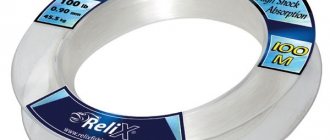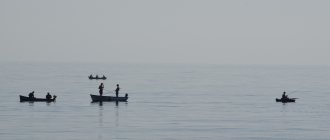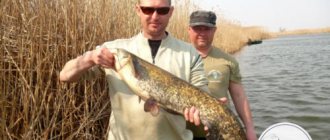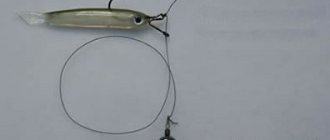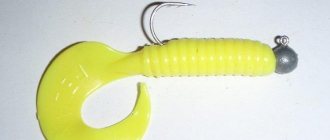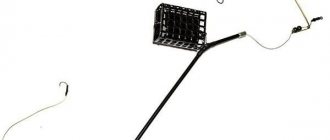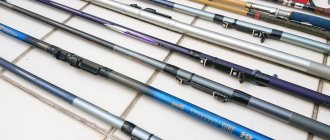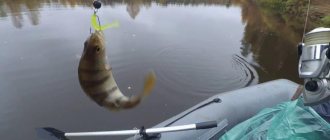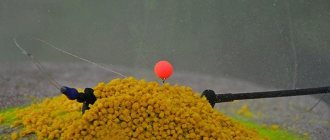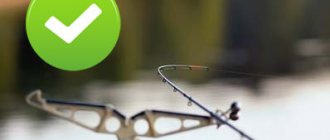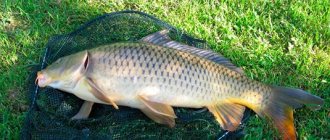A knotless fastener is one of the simplest and most ingenious inventions used in fishing rigs.
It helps reduce the number of cliffs and prevent the loss of production. Thanks to this simple and compact fishing part, there is no need to learn and remember many node connections used to fasten equipment elements. A small piece of wire, bent into various shapes, in the form of a pin or spring with loops for fastening, can simplify, speed up and make the fishing process more enjoyable.
In this article, we will understand the purpose of this miracle accessory, its advantages, determine the scope and places of application, talk about possible forms of knotless connections and teach how to install them correctly.
What is a knotless clasp?
A knotless fastener is a small fishing accessory made from a small piece of wire with curved ends, which allows you to install parts of the equipment without tying fishing knots.
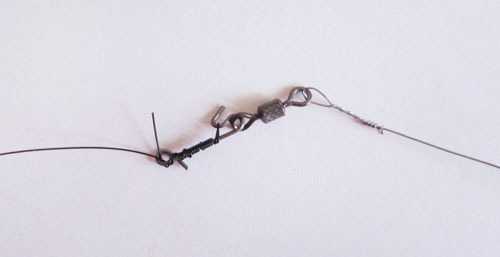
What does this do for the equipment? Firstly, the fishing thread used retains its original characteristics, which extends its service life. Secondly, the resulting structure becomes more durable, since it is devoid of nodal connections, which are considered the most vulnerable areas of installation.
Thanks to the fishing clasp, the resulting equipment can be easily disassembled by replacing its parts with others (for example, a twister with a vibrotail, or replacing a jig head, Cheburashka, etc.).
What is stronger is a knot or a knotless one, amateur fisherman A. Slepnev will tell you in his video
Characteristics of a nodeless connection
The design of the knotless design is determined based on the material used to make the accessory (metal wire) and is characterized by:
- elasticity;
- strength;
- resistance to corrosion.
Different knotless models differ not only in shape, but also in breaking load. A fastener is considered good if, under critical loads, it is deformed (stretched, twisted), but does not unfasten.
For example, the area of application of the fastener, depending on its design features, is ultralight when using mini wobblers and poppers. With this type of spinning fishing, light-weight fasteners are used, made of thin wire material and small in size, since they have minimal resistance in the water and do not affect the play of baits, for example, wobblers.
2.1 Knotless connection test and size
Like all equipment elements, knotless ones also have their own weight and dimensional characteristics, which are indicated by the manufacturer on the packaging, for example, test (strength) 15 kg, 35 kg and size S, XL, etc.
The knotless fastener test is a characteristic that indicates the strength of an element when exposed to a specific weight. If the specified figure is exceeded, the knotless part may become deformed or break.
Advice - select knotless ones with a test slightly less than the strength of the fishing line in order to preserve the fishing line and allow the connector to deform under excessive loads rather than the fishing line.
All the most interesting things about monofilament fishing line - read here
Content
A knotless fastener is a small fishing accessory made from a small piece of wire with curved ends, which allows you to install parts of the equipment without tying fishing knots.
What does this do for the equipment? Firstly, the fishing thread used retains its original characteristics, which extends its service life. Secondly, the resulting structure becomes more durable, since it is devoid of nodal connections, which are considered the most vulnerable areas of installation.
Thanks to the fishing clasp, the resulting equipment can be easily disassembled by replacing its parts with others (for example, a twister with a vibrotail, or replacing a jig head, Cheburashka, etc.).
What is stronger is a knot or a knotless one, amateur fisherman A. Slepnev will tell you in his video
The design of the knotless design is determined based on the material used to make the accessory (metal wire) and is characterized by:
- elasticity;
- strength;
- resistance to corrosion.
Different knotless models differ not only in shape, but also in breaking load. A fastener is considered good if, under critical loads, it is deformed (stretched, twisted), but does not unfasten.
For example, the area of application of the fastener, depending on its design features, is ultralight when using mini wobblers and poppers. With this type of spinning fishing, light-weight fasteners are used, made of thin wire material and small in size, since they have minimal resistance in the water and do not affect the play of baits, for example, wobblers.
Like all equipment elements, knotless ones also have their own weight and dimensional characteristics, which are indicated by the manufacturer on the packaging, for example, test (strength) 15 kg, 35 kg and size S, XL, etc.
The knotless fastener test is a characteristic that indicates the strength of an element when exposed to a specific weight. If the specified figure is exceeded, the knotless part may become deformed or break.
Advice - select knotless ones with a test slightly less than the strength of the fishing line in order to preserve the fishing line and allow the connector to deform under excessive loads rather than the fishing line.
All the most interesting things about monofilament fishing line - read here
With the use of knotless fishing equipment, an important problem is solved - connecting equipment elements without the use of fishing knots.
What problems might arise? Unpredictability of braided line breakage (for example, with a diameter of 0.2 mm).
After all, when a knot is tied, the fisherman already assumes and allows for a break in the installation in this very place, but when using a knotless element, it is impossible to determine the area of the break, since it is impossible to know in advance where the manufacturing defect lies in a particular accessory. This is the main disadvantage of using a knotless fastener. Also, as a disadvantage, we can highlight the weight factor of the fishing rod equipment.
Advice: always carefully check all elements of equipment (swivels, crimp tubes, leashes, fish hooks, etc.) for quality and the absence of visual defects, to avoid breaks.
Area of application - mainly spinning fishing for predators (for example, pike, catfish, living in freshwater and flatheads, scorpion fish, sea dragon, faridae and other owners of the Mediterranean Sea).
Places of application - unsnaggled and algae-free areas of a reservoir with a clean bottom (for example, such areas are chosen when catching pike by twitching with minnow wobblers). Under such ideal fishing conditions, hooks are excluded, and the braided line used can be taken with the smallest diameter, which will ensure the flight range of the bait.
This type of knotless connection is especially popular among sports fishermen, for whom the speed of changing equipment is sometimes a fundamental factor in winning.
The variety of knotless fasteners is inextricably linked with their area of application. When choosing a particular fastener, you must take into account the following conditions:
- the dimensions of the bait, if the bait is large, then the fastener should have the appropriate dimensions and vice versa;
- the thickness (diameter) of the braided cord, the number of the knotless connection or the thickness of the wire of the product must correspond to the thickness of the braid;
- test the gear, since a powerful spinning rod requires appropriate equipment and the knotless rod must be made of thick wire and the required size to be in harmony with the rest of the mounting accessories.
As for choosing the shape of a knotless hook, at this point you should pay attention to the eye (loop) of the fastener itself, since its size will play an important role when attaching a particular bait, that is, its dimensions. The shape of the accessory itself only plays a role in the matter of personal preference of the angler.
- Thus, the following forms of knotless clasps are distinguished (on each of the links you will find a detailed description of the clasp and the cheapest offers for this product on the aliexpress website):
- A knotless clasp on a long leg will be very useful in microjig fishing, when a quick change of bait is required, and its design allows you to easily and comfortably hold the clasp with your fingers and perform all kinds of manipulations;
- Classic knotless, indispensable for attaching small baits;
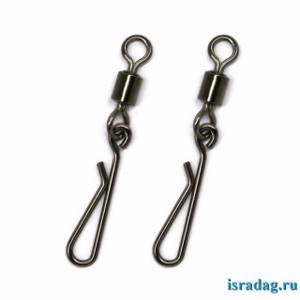
A knotless fastener with a swivel is designed to solve a number of issues, including twisting of the fishing line, reducing friction of mounting elements, etc.;- A swivel with a knotless spiral clasp (carabiner) will be indispensable in leash installations.
Here you can find a selection of the best deals on fishing products we found on the aliexpress website. Thanks to this catalog, you can reduce the cost of installing gear by 2, and sometimes 5 or more times.
We suggest you read: How to tie two hooks on a fishing rod so they don’t get confused in different ways

You will find a detailed description of various products, their characteristics and justification for the benefits of purchasing them.
Tip: when winding fishing line onto a fastener of any shape, it is better to wet it first to ensure the strength of the interaction between these two elements.
Scheme for knitting cord to knotless
In this video you will learn in detail about the correct knitting of a knotless braid
Scheme for installing a knotless wobbler
And in this video, you will clearly learn how to equip a wobbler with a knotless
A knotless fastener for fishing can be purchased in specialized fishing stores in your city or in online fishing stores.
However, we suggest you pay attention to the online hypermarket aliexpress, which has long become one of the most popular online stores among fishermen around the world.
This is not surprising, because with its help you can reduce the cost of fishing equipment by 3, 5 or more times. Don't believe me? Read the results of our experiment.....
So that you don’t have to waste time and delve into the wilds of Aliexpress, for your convenience we have made a selection of the most delicious offers with the best prices and reviews.
Who doesn't know yet? You can return up to 15% of the price of your purchase on aliexpress. In addition to Aliexpress, the possibility of cashback (returning part of the money) also works for many other online stores.
Here is a detailed description of this service and everything about how to work with it. It really works and helps you save a lot of money.
The cashbacker website often runs promotions that allow you to buy goods at a discount of up to 90%.
useful links
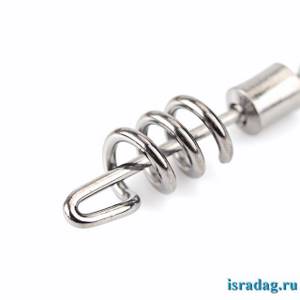
https://charka.org.ua/bezuzlovaya-zastezhka/ - article about knotless fasteners and methods of their use;
Disadvantages of knotless
With the use of knotless fishing equipment, an important problem is solved - connecting equipment elements without the use of fishing knots.
What problems might arise? Unpredictability of braided line breakage (for example, with a diameter of 0.2 mm). After all, when a knot is tied, the fisherman already assumes and allows for a break in the installation in this very place, but when using a knotless element, it is impossible to determine the area of the break, since it is impossible to know in advance where the manufacturing defect lies in a particular accessory. This is the main disadvantage of using a knotless fastener. Also, as a disadvantage, we can highlight the weight factor of the fishing rod equipment.
Advice: always carefully check all elements of equipment (swivels, crimp tubes, leashes, fish hooks, etc.) for quality and the absence of visual defects, to avoid breaks.
How to use a knotless
The connection of the braid with the bait through a wire device is carried out according to the following scheme.
- First of all, it is important to select the knotless size according to the thickness of the cord. It is allowed to use a connector with a wire thicker than the fishing line.
Photo 2. Connect the fastener with the wobbler ring.
Photo 3. Finished connection.
If at the first attempt the question may arise about how to tie a knotless hook, then each subsequent change of bait will happen faster and more clearly.
The need to use a knotless fastener depends on the fishing method. Since no costs are required to make the connector, you can make several of these elements yourself and put them in a fishing box. Perhaps at some point, the clasp will be needed and will help the fisherman remove the desired trophy from the water.
Where is a knotless fastener used?
Area of application - mainly spinning fishing for predators (for example, pike, catfish, living in freshwater and flatheads, scorpion fish, sea dragon, faridae and other owners of the Mediterranean Sea).
Places of application - unsnaggled and algae-free areas of a reservoir with a clean bottom (for example, such areas are chosen when catching pike by twitching with minnow wobblers). Under such ideal fishing conditions, hooks are excluded, and the braided line used can be taken with the smallest diameter, which will ensure the flight range of the bait.
This type of knotless connection is especially popular among sports fishermen, for whom the speed of changing equipment is sometimes a fundamental factor in winning.
In what variants of spinning fishing does this installation occur:
- microjig (using silicone baits);
- ultralight (using spinners, spinners, wobblers);
- when fishing with surface spinning baits;
- for installation of braided fishing line;
- when using a leash (where the knotless one is installed in its various parts: at the beginning, at the end).
How to tie a clasp without knots
It is worth considering the features of a knotless fastener , how to tie it correctly and more firmly:
- First, choose a clasp. It is important to accurately find the required size in accordance with the parameters of the bait and the characteristics of the fishing line.
- To make a knotless one, you need to prepare steel wire with a diameter of up to 1 cm, using wire cutters and pliers.
- The wire should not be crooked or uneven at the end. If such defects exist, remove the piece.
- The clasp should be more massive. The next step is insertion into the ear.
- Thread the fishing line onto the hook of the connector. It should be double. Wind it about 6 times. If the fishing line is large, 2-3 turns are enough.
- Next, it is placed in the clamp and tightened. The remaining pieces can be removed. Do-it-yourself knotless knitting is best done using braided yarn.
- Round nose pliers are needed to bend the end 180°. The bend needs to be turned in a different direction. You also need to bend the end of the wire. The hook should come out.
- The other end also needs to be bent, only at 90°. This is how we make a loop.
Professional fishermen install the fastener on wet fishing line. This provides a stronger structure.
A knotless braided connection is suitable for those who like to fish near the shore with a fishing rod.
What are the different shapes of knotless ones?
The variety of knotless fasteners is inextricably linked with their area of application. When choosing a particular fastener, you must take into account the following conditions:
- the dimensions of the bait, if the bait is large, then the fastener should have the appropriate dimensions and vice versa;
- the thickness (diameter) of the braided cord, the number of the knotless connection or the thickness of the wire of the product must correspond to the thickness of the braid;
- test the gear, since a powerful spinning rod requires appropriate equipment and the knotless rod must be made of thick wire and the required size to be in harmony with the rest of the mounting accessories.
As for choosing the shape of a knotless hook, at this point you should pay attention to the eye (loop) of the fastener itself, since its size will play an important role when attaching a particular bait, that is, its dimensions. The shape of the accessory itself only plays a role in the matter of personal preference of the angler.
Thus, the following forms of knotless clasps are distinguished ( for each of the links you will find a detailed description of the clasp and the cheapest offers for this product on the aliexpress website ):
A knotless clasp on a long leg will be very useful in microjig fishing, when a quick change of bait is required, and its design allows you to easily and comfortably hold the clasp with your fingers and perform all kinds of manipulations;
Classic knotless, indispensable for attaching small baits;
A knotless fastener with a swivel is designed to solve a number of issues, including twisting of the fishing line, reducing friction of mounting elements, etc.;
A swivel with a knotless spiral clasp (carabiner) will be indispensable in leash installations.
Here you can find a selection of the best deals on fishing products we found on the aliexpress website. Thanks to this catalog, you can reduce the cost of installing gear by 2, and sometimes 5 or more times. You will find a detailed description of various products, their characteristics and justification for the benefits of purchasing them. And if you spend 10 minutes and learn how to use cashback, you can additionally save up to 15% on all purchases in a Chinese hypermarket.
Tip: when winding fishing line onto a fastener of any shape, it is better to wet it first to ensure the strength of the interaction between these two elements.
Advantages and disadvantages of a knotless fastener for braided cord
One of the serious problems for fishing enthusiasts has been the unreliability of connections on the equipment. The tensile strength of the fishing line declared by the manufacturer is significantly reduced at the knots. In order to maintain the breaking force as much as possible, fishermen have come up with many knots with minimal kinks in the thread. A knotless braided clasp can be a useful tool. This element will preserve the technical parameters of the cord and will also speed up the installation process of the equipment. What is a “Not a knot” clasp?
Knotless fishing element
A knotless connection helps reduce the number of bait breaks and prevent large fish from leaving. Thanks to the simple and compact part, there is no need to remember the intricacies of new knots in order to tie the bait to the fishing line. The connector is a wire device with special bends at the ends. For the manufacture of this element, stainless steel wire is most often used. Knotless fasteners are now offered to fishing enthusiasts by many specialized stores. It’s easy to make a wire device with your own hands.
But it’s not enough to purchase or make a clever fastener. It is important to learn how to use this part when connecting braided line with artificial baits.
In some cases, the use of a connector impairs the performance of the gear. Therefore, before installing a new accessory on a fishing rod, you should familiarize yourself with the strengths and weaknesses of a knotless line connection.
Advantages and disadvantages of knotless
There are two ways to attach a leash or bait to the main line. Some anglers continue to use knots, while others prefer a knotless fastener. Each of these methods has its own area of application, which is determined by the strengths and weaknesses of the compounds.
The advantages of conventional nodes include:
- the ability to tie different fishing lines and braids;
- breakage of equipment most often occurs at the node;
- There are no additional elements on the equipment.
As for the weaknesses of nodal connections, it is necessary to highlight the inconvenience of forming a node and low strength.
Knotless clasps have their advantages and disadvantages.
- One of the important advantages of the “Not a knot” connector is the prevention of fraying of the cord when fishing for large fish.
- The wire device allows you to quickly change or tie baits or equipment. It takes any angler 10-20 seconds to install. Athletes especially value time during competitions.
- The absence of knots makes the equipment very strong, since weak points are eliminated.
Knotless clasps also have some limitations.
- This method of mounting baits is mainly suitable for braided cord.
- An additional detail appears on the equipment, which makes the fishing rod heavier.
- With a dead hook, when you have to pull out the rig by holding the fishing line, a break can occur on any section of the cord. It's a shame to lose a long piece of expensive thread.
The fisherman must independently determine which installation method is best suited for him. For spinning and feeder players using braid, it will be useful to use a connector. But for lovers of a float or ultralight, a regular knot looks preferable.
How to make a knotless clasp
Making a wire element yourself has its positive aspects. The fisherman can make a fastener for the tackle, taking into account the thickness of the fishing line and the size of the bait. To make a part you need to equip yourself with the following tools:
The connector can be made from steel wire with a diameter of 0.12-0.8 mm. Anglers most often use guitar strings or wire made from steel ropes, cables, chucks, etc.
Do-it-yourself knotless fastener is made according to the following scheme.
- First, one end of the wire is processed with a file or sandpaper so that there are no sharp edges.
- Using round-nose pliers, bend the wire 180 degrees. After about 5-7 mm, the tip of the wire turns in the opposite direction again. Bends can be corrected using pliers.
- Next, cut off the excess wire using wire cutters. Burrs are removed with a file.
- Then, using pliers, a loop is made. It is important to bend the tip of the wire to the main section of the connector using pliers.
Photo 1. For clarity, we made a fastener from colored wire.
How to use a knotless
The connection of the braid with the bait through a wire device is carried out according to the following scheme.
- First of all, it is important to select the knotless size according to the thickness of the cord. It is allowed to use a connector with a wire thicker than the fishing line.
Photo 2. Connect the fastener with the wobbler ring.
Photo 3. Finished connection.
If at the first attempt the question may arise about how to tie a knotless hook, then each subsequent change of bait will happen faster and more clearly.
The need to use a knotless fastener depends on the fishing method. Since no costs are required to make the connector, you can make several of these elements yourself and put them in a fishing box. Perhaps at some point, the clasp will be needed and will help the fisherman remove the desired trophy from the water.
Where can I buy a knotless
A knotless fastener for fishing can be purchased in specialized fishing stores in your city or in online fishing stores. However, we suggest you pay attention to the online hypermarket aliexpress, which has long become one of the most popular online stores among fishermen around the world. This is not surprising, because with its help you can reduce the cost of fishing equipment by 3, 5 or more times. Don't believe me? Read the results of our experiment.....
So that you don’t have to waste time and delve into the wilds of Aliexpress, for your convenience we have made a selection of the most delicious offers with the best prices and reviews.
Who doesn't know yet? You can return up to 15% of the price of your purchase on aliexpress. In addition to Aliexpress, the possibility of cashback (returning part of the money) also works for many other online stores. Here is a detailed description of this service and everything about how to work with it. It really works and helps you save a lot of money. The cashbacker website often runs promotions that allow you to buy goods at a discount of up to 90%.
